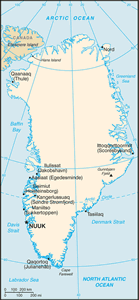The Geography of Greenland
The Geography of Greenland
Greenlandic Geography
Location: Northern North America, island between the Arctic Ocean and the North Atlantic Ocean, northeast of Canada
Geographic coordinates: 72 00 N, 40 00 W
Map references: Arctic Region
Area: total: 2,166,086 sq km land: 2,166,086 sq km (410,449 sq km ice-free, 1,755,637 sq km ice-covered) (2000 est.)
Area - comparative: slightly more than three times the size of Texas
Land boundaries: 0 km
Coastline: 44,087 km
Maritime claims: territorial sea: 3 nm exclusive fishing zone: 200 nm or agreed boundaries or median line continental shelf: 200 nm or agreed boundaries or median line
Climate: arctic to subarctic; cool summers, cold winters
Terrain: flat to gradually sloping icecap covers all but a narrow, mountainous, barren, rocky coast
Elevation extremes: lowest point: Atlantic Ocean 0 m highest point: Gunnbjorn 3,700 m
Natural resources: coal, iron ore, lead, zinc, molybdenum, diamonds, gold, platinum, niobium, tantalite, uranium, fish, seals, whales, hydropower, possible oil and gas
Land use: arable land: 0% permanent crops: 0% other: 100% (2005)
Irrigated land: NA
Natural hazards: continuous permafrost over northern two-thirds of the island
Environment - current issues: protection of the arctic environment; preservation of the Inuit traditional way of life, including whaling and seal hunting
Environment - international agreements:
Geography - note: dominates North Atlantic Ocean between North America and Europe; sparse population confined to small settlements along coast; close to one-quarter of the population lives in the capital, Nuuk; world's second largest ice cap


